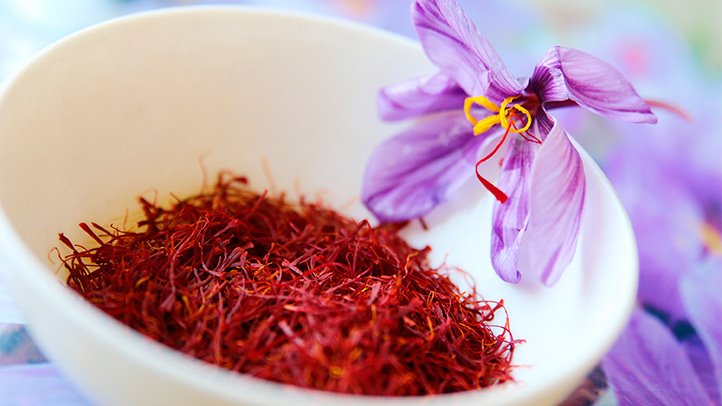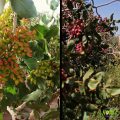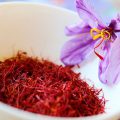Saffron is:
an orange-yellow flavouring, food colouring, and dye made from the dried stigmas of a crocus.
an autumn-flowering crocus with reddish-purple flowers, native to warmer regions of Eurasia. Enormous numbers of flowers are required to produce a small quantity of the large red stigmas used for the spice.

Saffron is one of the most precious spices in the world. The threadlike red stigmas—and the yellow hue they impart—are quite literally the stuff of legend. But what is saffron, exactly? No matter how many tales have been told about the spice, a lot of us still don’t know what to do with it or whether its worth the high cost. Here’s everything you need to know.
Where does saffron come from?
The spice originates from a flower called crocus sativus—commonly known as the “saffron crocus.” It is believed that saffron originated and was first cultivated in Greece, but today the spice is primarily grown in Iran (Persia), Greece, Morocco, and India. While micro-scale production of saffron does exist in the United States, most saffron found here is imported.
What does it taste like?
Saffron is extremely subtle and fragrant. The slightly sweet, luxurious taste is totally enigmatic—it’s tricky to describe but instantly recognizable in a dish. As annoying as it is to say, you know it when you taste it.
Saffron, golden spice for cooking
Yes, you can also eat it. This is not new as it was already used in the kitchen under King Solomon’s reign. Saffron is a spice and it is used in cooking for its flavour as well as the golden yellow colour it gives to dishes.
It is well known and very appreciated with fish like in paella, bouillabaisse (fish stew), but also in tajines, Italian risotto… It is also found in puddings, like saffron puddings, in particular, saffron crèmes brûlées. When saffron is used to make syrup, it can be used to make original cocktails like kirs, punches…and an excellent topping for making puddings as rum babas.
Saffron, a medicine?
And it is a cure as well! This has been known for a very long time as Hippocrates recommended it for indigestion and toothache. In the East, it is said to bring wisdom and cheerfulness, used for a long time to treat hysteria in association with opium. Good for blood circulation, it would relieve menstrual pains and would apparently be an aphrodisiac for women. Nowadays, Crocus Sativus is still prescribed in homoeopathy for women blood circulation troubles.
How should I use it?
Grind 2 tsp. saffron threads, along with a sugar cube or a pinch of coarse salt, to a powder with a mortar and pestle or a spice mill to draw out the most flavour and colour. Then add ¼ cup warm water and let cool. This is the vibrant elixir to use in your paella, buttery saffron rice, and special occasion desserts like saffron-rose water brittle.
Saffron is at the top of its game in rice dishes like paella but can be a succulent addition to desserts, too. Here’s a good rule of thumb: if vanilla is included, saffron will thrive! Even a small amount adds fragrant flavour and a burst of golden colour to brighten up your dish. It can either be the star of the show or added in combination with other spices to provide sweet flavour and depth.
To get the most colour and taste, soak the saffron threads in a water or broth before cooking for at least thirty minutes, and add the infused liquid right before you serve.
Pro Tip: Avoid using wooden utensils, which can absorb some of the flavours.
Why is it so expensive?
Each flower produces only three threads (stigmas) of saffron, and it blooms for only one week each year. The saffron must be harvested—by hand!—in the mid-morning when the flowers are still closed in order to protect the delicate stigmas inside.
It takes about 1,000 flowers to produce just one ounce of saffron. That’s why you’ll pay $10 to $13 per gram for the real deal. To make sure you’re getting the best stuff, take a sniff—you want saffron that smells a bit like sweet hay. It should also have all red stigmas, no yellow stamens.
Where do I buy it?
You can buy saffron from us (Noble Exotic), in Canada and USA.
How do I store saffron?
Keep threads in a cool, dry, dark place (you can put it in the freezer for up to a year). Saffron water can be stored in the fridge in an airtight container for up to three weeks.
Types
The various saffron crocus cultivars give rise to thread types that are often regionally distributed and characteristically distinct. Varieties (not varieties in the botanical sense) from Spain, including the tradenames “Spanish Superior” and “Creme”, are generally mellower in colour, flavour, and aroma; they are graded by government-imposed standards. Italian varieties are slightly more potent than Spanish. Greek saffron produced in the town of Krokos is PDO protected due to its particularly high quality colour and strong flavour.[46] Various “boutique” crops are available from New Zealand, France, Switzerland, England, the United States, and other countries—some of them organically grown. In the US, Pennsylvania Dutch saffron—known for its “earthy” notes—is marketed in small quantities.
Consumers may regard certain cultivars as “premium” quality. The “Aquila” saffron, or zafferano dell’Aquila, is defined by high safranal and crocin content, distinctive thread shape, unusually pungent aroma, and intense colour; it is grown exclusively on eight hectares in the Navelli Valley of Italy’s Abruzzo region, near L’Aquila. It was first introduced to Italy by a Dominican monk from Inquisition-era Spain.[when?] But the biggest saffron cultivation in Italy is in San Gavino Monreale, Sardinia, where it is grown on 40 hectares, representing 60% of Italian production; it too has unusually high crocin, picrocrocin, and safranal content. Another is the “Mongra” or “Lacha” saffron of Kashmir (Crocus sativus ‘Cashmirianus’), which is among the most difficult for consumers to obtain. Repeated droughts, blights, and crop failures in Kashmir combine with an Indian export ban, contribute to its prohibitive overseas prices. Kashmiri saffron is recognisable by its dark maroon-purple hue; it is among the world’s darkest, which hints at strong flavour, aroma, and colouring effect.



